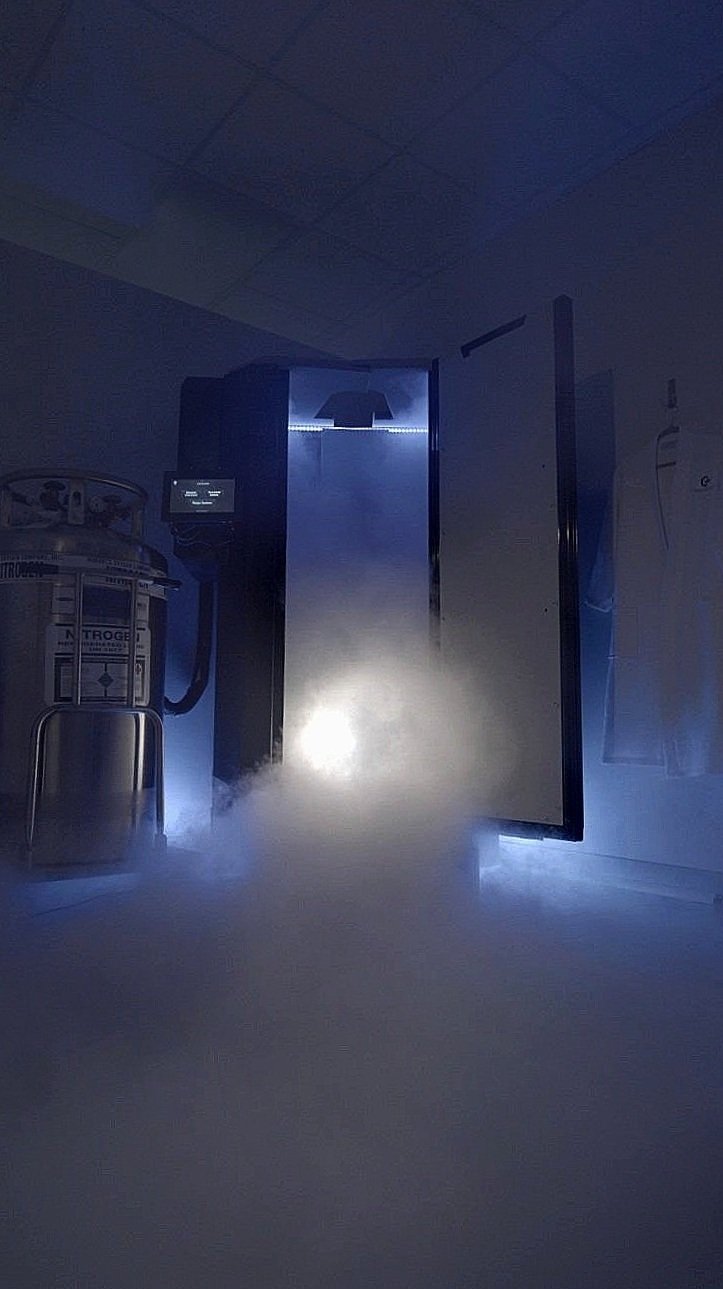
WHOLE-BODY CRYOTHERAPY
LESS THAN 3 MINUTES OF CRYOTHERAPY WILL SUPERCHARGE YOUR BODY’S IMMUNE SYSTEM AND STIMULATE ITS NATURAL HEALING RESPONSE.
INCREASE YOUR ENERGY
•
BOOST IMMUNE SYSTEM
•
RELIEVE PAIN
•
INCREASE YOUR ENERGY • BOOST IMMUNE SYSTEM • RELIEVE PAIN •
When your body is exposed to extreme cold, it triggers your bodies fight or flight response by constricting your blood vessels, then pushing blood to your vital organs.
This causes the blood to acquire more oxygen and become nutrient rich — triggering a chain reaction of health benefits you’ll notice the moment your session is complete.
🏷️ $35 FIRST TIME SPECIAL

BENEFITS
✅ Muscle Healing
✅ Relieve Pain
✅ Treat Arthritis
✅ Migraine Headaches
✅ Oxygenate Blood
✅ Boost Antioxidants
✅ Strengthen Immune System
✅ Skin Conditions
Duration: 3 Minutes
MOUNTAIN VIEW
FAQs
-
Whole-Body Cryotherapy is a treatment that exposes the body to extremely cold temperatures, typically between -110°C to -140°C (-166°F to -220°F), for a short duration (usually 2-4 minutes). The exposure to cold air stimulates various physiological responses aimed at pain relief, muscle recovery, and overall wellness.
-
During the session, the body is briefly exposed to extreme cold in a cryotherapy chamber. The cold triggers vasoconstriction (narrowing of blood vessels), followed by vasodilation (expansion of blood vessels) once you exit the chamber. This process increases blood flow, reduces inflammation, and helps speed up muscle recovery.
-
Yes, whole-body cryotherapy is generally safe when conducted under the supervision of trained professionals. However, people with certain medical conditions (such as heart disease, respiratory issues, or extreme cold sensitivity) should consult their doctor before trying WBC.
-
Common benefits include:
Reduced muscle soreness and joint pain
Faster recovery from exercise or injury
Decreased inflammation
Enhanced mood and energy levels
Improved skin tone and reduced signs of aging
Boosted metabolism and potential weight loss
Relief from chronic pain conditions (e.g., arthritis, fibromyalgia)
-
Cryotherapy is often used as a complementary therapy for conditions like:
Chronic pain (e.g., arthritis, fibromyalgia)
Muscle injuries
Inflammatory conditions (e.g., tendinitis)
Anxiety and depression (due to endorphin release) It is not a replacement for medical treatment, and anyone with a medical condition should consult their doctor before starting WBC.
-
Sessions last 3-minutes. The exposure to extreme cold is brief but intense.
-
The frequency depends on your goals. For general wellness, 3-5 sessions per week are common. Athletes and people seeking relief from chronic pain may do it more frequently. Your provider will recommend a plan based on your specific needs
-
You will typically wear minimal clothing, such as a bathing suit or underwear. To protect sensitive areas, you will be provided with gloves, socks, slippers, and sometimes earmuffs or a headband. We also offer a robe to wear while waiting for your session.
-
Yes, many athletes use cryotherapy to enhance recovery and reduce muscle soreness after intense workouts or competition. By lowering inflammation and accelerating muscle recovery, WBC can help improve athletic performance and reduce downtime.
-
Whole-body cryotherapy is not a primary weight-loss treatment, but it may help boost metabolism by stimulating the body’s thermogenic response (the process of heat production). Studies suggest that cold exposure can lead to an increase in calorie expenditure, potentially aiding weight loss when combined with diet and exercise.
-
No, whole-body cryotherapy is not painful, but you will feel very cold. Most people describe it as a strong but tolerable sensation of cold, similar to standing in a freezer. Some report feeling a tingling sensation as blood rushes back to the extremities after the session.
-
While both involve cold exposure, WBC uses dry cold (via nitrogen vapor or cold air) and operates at much lower temperatures than an ice bath. An ice bath uses cold water and is typically between 50°F and 59°F, while WBC temperatures can drop to -220°F. WBC is less uncomfortable than an ice bath and offers quicker exposure times.
-
No, there is no downtime after WBC. Most people feel energized immediately after their session and can return to their normal activities. In fact, many experience an endorphin boost that leads to improved mood and energy levels.
-
Whole-body cryotherapy is not recommended for individuals with:
Severe heart conditions or pacemakers
Uncontrolled high blood pressure
Cold-induced asthma or respiratory issues
Raynaud’s disease or cold sensitivity disorders
Pregnant women or those with blood circulation issues should also avoid WBC. Always consult a doctor before starting WBC, especially if you have any health concerns.
-
Results vary based on the individual and the purpose of the treatment. Most people report immediate benefits such as reduced pain, improved mood, and increased energy. For chronic pain relief, inflammation reduction, or enhanced athletic recovery, multiple sessions may be needed before seeing significant results.




